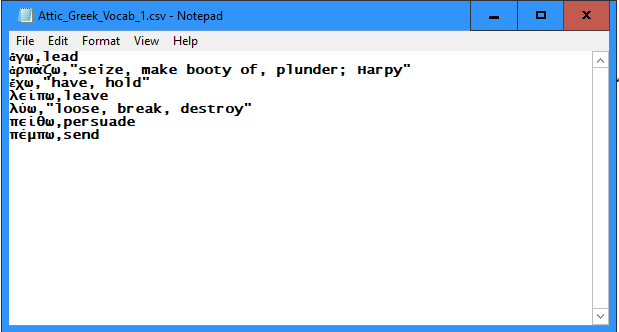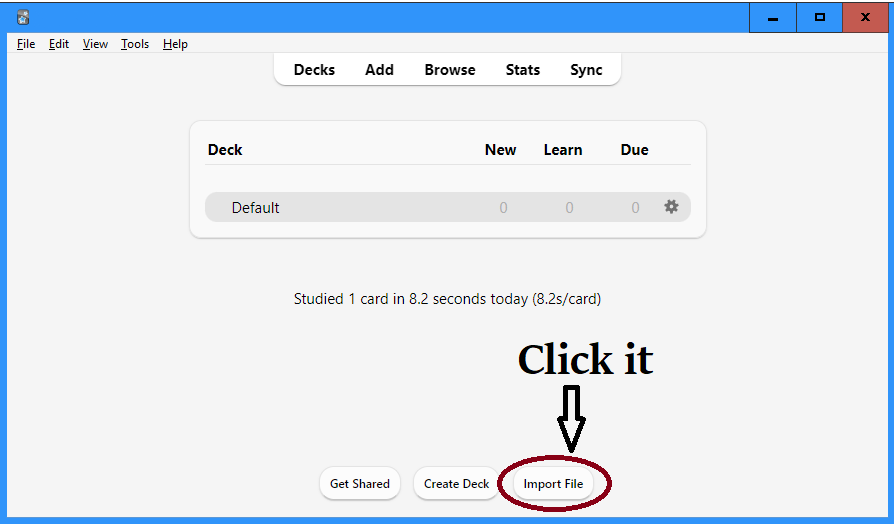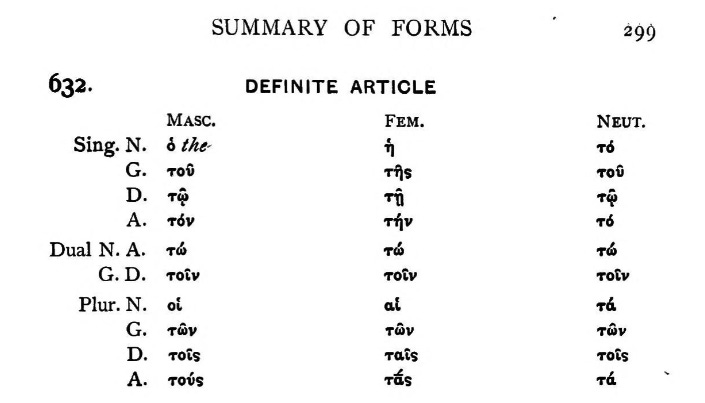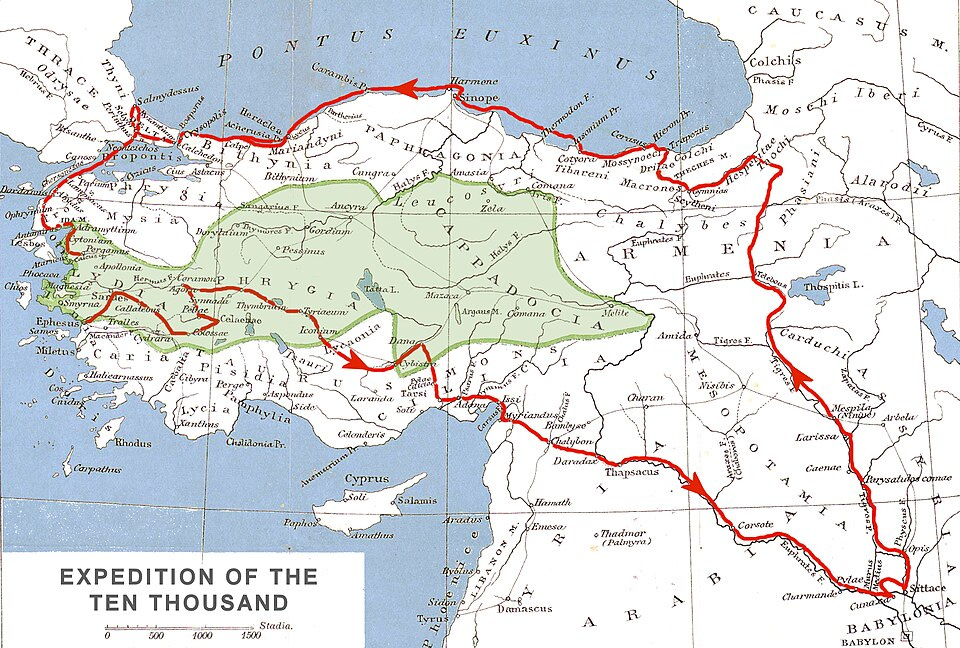What follows intends to be an entirely practical guide to learning Ancient Greek. I will not vainly attempt to persuade you that this endeavor is worthwhile or easy. Greek is an absolute bitch to learn. When accounting for all the voices, tenses, moods, infinitives, and participles, there can be hundreds of different forms for a single Greek verb. It requires rote memorization, time, and effort. Expect many hours of practice, flashcards out the wazoo, and repeatedly running into frustrating grammatical irregularities.
Hopefully that introduction scared off those of you with weak wills. Learning Greek isn’t all that bad, but it is a substantial time commitment. And, despite the difficulty, it can be fun if done correctly.
So—how do you get started? I don’t think paying for classes or lessons is necessary. There are plenty of materials online which are free to use. More importantly, however, all education is self-education. You only learn when you yourself put in the effort. You cannot pay tutors to memorize the vocabulary on your behalf. This guide is meant to be entirely practical. I will tell you which resources are out there, where you can find them online, and how you can effectively use them to aid in your studies.
Attic Greek
Attic Greek was the dialect of ancient Athens during its classical height. It is the language of Plato, Thucydides, the tragedians, and was later adopted as the literary standard across the Greek-speaking world. The Greeks spoke different variants of their language depending on their geographical location, their ethnicity (e.g., Aeolians, Achaeans, Ionians, Dorians), and the time period in which they lived. Attic Greek is a member of the Ionic branch of the Greek language and is named after the region whence it emerged (Attica, which includes Athens and the surrounding area). It later became the basis for Koine [Common] Greek which spread around the Mediterranean region and Middle East in the wake of Alexander the Great’s conquests. If you learn Attic Greek, you should be able to also read Koine Greek. However, Homeric Greek—the older, literary style of Homer—is another matter. It might prove challenging to first learn Attic Greek and then expect to be able to read Homer. The recommendations I make in this guide are primarily for learning Attic Greek.
Foundations
Of the many textbooks available, the important thing is not which one you choose, but that you choose one and commit to it. That being said, I do have an unorthodox suggestion: Beginner’s Greek Book by Benner and Smyth (1906). You can access the text on Archive.org with this link (https://archive.org/details/cu31924012536243/).
There are a few reasons behind this suggestion. First, the lessons are rather short—usually around 5 pages per lesson. Each lesson ends with a set of translation exercises (both from Greek to English and from English to Greek). The brevity of each lesson permits the student some flexibility. Depending on your own schedule, you might elect to do one lesson per day. In theory, you could finish the entire book in roughly 60 days.
However, I wouldn’t recommend this as this doesn’t give you enough time to practice your retention of grammar and vocabulary. I would split up each of the 60 lessons into 3 very manageable pieces:
1) Reading the lesson.
The goal here is to read the lesson all the way through and to learn whatever grammar is taught in that particular lesson. For example, Lesson I (pg. 29 - 30) focuses on the present indicative active Ω-verbs in the active voice. You should read through each section (§40 - 47 for Lesson I) carefully and seek to memorize what is being taught. When Benner & Smyth tell you what the “stem” of a Greek verb is, jot down a note and memorize it. When they tell you what a “thematic vowel” is, write it down and memorize it. This can be tedious, but failure to do so at this stage will simply create a headache later on. If you find any of their explanations unsatisfactory or vague, do not be afraid to search it up using google, ChatGPT, or Grok. There are plenty of resources out there. Also, when reading the lessons, say the words in Greek out loud. This will help your pronunciation and, eventually, you will develop an intuition for where the accents go on these Greek words.
2) Vocabulary.
You need to be using Anki. Anki is a free, open-source flashcard program that uses spaced repetition to help you remember information more efficiently. Instead of showing you every card every day, Anki schedules each card based on how well you know it. Easy cards reappear after longer intervals, and difficult cards show up sooner. This method is based on cognitive science research showing that spacing out review sessions strengthens long-term memory. You can download Anki here (https://apps.ankiweb.net/).
There are already large Anki sets out there for Attic Greek which can be found rather easily with a quick search online. Those are fair game but just know that you may be out of sync with your textbook. I recommend making your own Anki set as you go along. Typing the words out in Greek with the proper accentuation and diacritical markings can be a bit of a hassle so save yourself some time and just use Grok or ChatGPT to make the set for you. Open the PDF of Benner & Smyth, and zoom in on the vocabulary section for Lesson I (§46, on page 30). Take a screenshot (winkey + shift + s) and paste that screenshot into a Grok or ChatGPT window and say something like “Turn this screenshot into an Anki-ready CSV (UTF-8) with two columns: Greek word (with full accents/breathings) and English meaning.”
It should create a CSV file that, when opened in Notepad, looks something like this:
If it includes any text other than the vocabulary (for example, a header saying GREEK VOCAB), delete that portion. Double check to make sure Grok or ChatGPT transcribed the vocabulary correctly. Sometimes, it makes mistakes (albeit rarely with this task). Now is your opportunity to fix them.
Go into Anki and look at the bottom. There should be 3 buttons including one that says “Import File”). Click it. Import the file provided to you by Grok or ChatGPT.
You need to make sure you have the right field separator (essentially, this is what tells Anki which is side 1 and which is side 2 of the digital flashcard).
Click import and you should be all set to go. At the vocabulary stage of every lesson, you should repeat this process. Click “Default” to start grinding vocabulary. As you go through the vocabulary, Anki will ask you at the bottom how difficult the word was. Depending on how difficult the word was to recall, it will calculate how long it should be until you see that word again. Memorizing vocabulary is perhaps the single most important thing as you work toward the ability to read Greek unaided.
3) Exercises.
This is where I believe Benner & Smyth really shines. The preface tells us that the book intends to prepare the student to read Xenophon’s Anabasis. Accordingly, the vocabulary and exercises revolve around battles, sieges, heroic stands, and political intrigues which are all rendered in Xenophon’s characteristically crisp Attic prose. Instead of grinding through dull, artificial examples, you get to translate lines about hoplites charging the enemy, cavalry ambushes, and generals rallying their troops. It is immediately engaging and, from the very beginning, prepares you to read one of the greatest works from Classical Antiquity.
My recommendation is, again, to break up each lesson into these 3 sessions. You can do one session a day (each of which would take you no more than 30 minutes). You can get through the book’s 60 lessons in roughly 180 days. If that pace is too fast or too slow, just adjust accordingly. You can do 5 lessons a week, or you can do 1 lesson a week. That depends on how much time you have and how motivated you are.
Reading Greek
If you’ve followed my suggestions so far, then you are primed to read Xenophon’s Anabasis. The Anabasis is Xenophon’s firsthand account of a Greek mercenary army’s long, perilous march home through hostile territory after their employer’s bid for the Persian throne ends in disaster. Most of you will enjoy it thoroughly.
I recommend using Geoffrey Steadman’s PDFs which are available for free on his website (https://geoffreysteadman.com/). Just click on the author whom you wish to read. You should start with Xenophon’s Anabasis (https://geoffreysteadman.com/wp-content/uploads/2025/01/xen.anabasisbk1.04jan25.pdf). His PDFs are ideal since they pair the original Greek text with facing-page vocabulary and concise grammatical notes. This lets you stay immersed in the text without constantly flipping to a lexicon. However, you may still find the need to consult a lexicon every now and then. I recommend the “Middle Liddell” (available on Archive.org https://archive.org/details/intermediategree002716mbp/page/n5/mode/2up). A quick google search can also help. Alternatively, you can pull the Greek text on Perseus (https://www.perseus.tufts.edu/hopper/text?doc=Perseus%3Atext%3A1999.01.0201) and just click on the word in question.
Here is how you should go about using Steadman’s PDFs.
First, memorize the vocabulary. Steadman puts the most basic vocabulary for reading the text at the beginning of the PDF (pg. viii) under Running Core Vocabulary. These are all the words that occur eight times or more. You should know how to create Anki decks now but I would recommend keeping these under a different profile so as not to create repetition in your original deck (plus, your vocabulary is becoming a bit more specialized now that you’re reading a specific text).
Click “File” on the top left. Click “Switch profile”. Click “Add”. Name it “Xenophon Book 1”. Now add your specialized vocabulary list under this profile as shown previously. 90% of this vocabulary will already be known to you if you’ve gone through Benner & Smyth. A little refresher will not hurt you though if you’ve taken a break at any point. Once you’ve memorized that vocabulary, you should be set to begin reading and translating Xenophon’s Anabasis (assuming you’ve also memorized the grammar and morphology). I would recommend doing about 5 lines per session. As you find it becoming easier, ramp up from there. Focus on depth over speed.
If you’re looking for a good translation to compare yours to, check out the Cornell University Press series on Xenophon. They have excellent translations. However, they will not be 1:1 with the Greek, so don’t fret if you find minor differences between yours and theirs.
You don’t need to start with Xenophon’s Anabasis, however. I recommend it due to the simplicity of its style and its engaging content. If you’d prefer, you can start with any of the other PDFs that Steadman has available for free online. Just, don’t be surprised if you find some of the others strange. I would recommend going through Xenophon first. Then, Lysias’ On the Murder of Eratosthenes (which is also written in a clear style with simple syntax). From there, try your hand at Plato. The more difficult authors (Aristotle, the Tragedians, Thucydides, etc.) will take more time getting used to. But the same approach can be used.
Other Advice
Stay consistent.
Get Anki or another flashcard app on your phone so you can grind vocabulary anywhere.
Memorize the paradigms for the nouns and verbs. They chart out every possible form a word can take. Greek is a highly inflected language, meaning that the endings (and sometimes the beginnings) of words will change to indicate their grammatical role in a sentence. Benner & Smyth give you the full, unadulterated morphological charts in the back of the book starting on page 280. You need to memorize these as you go along. There are 63 of them (§592 - 655). I would recommend quizzing yourself on these regularly as you go through the book. As you finish each lesson, flip to the back of the book and find the corresponding section that lays out whatever paradigm you just learned. Quiz yourself on it until you’ve mastered it. Create a quizlet if you have to—up to you.
Memorize the definite articles (§632, page 299 of Benner & Smyth) first. They’re easy. And, provided they are attached to a noun, they will tell you what gender, number, and case the noun is in. If you’re not able to immediately parse the noun, knowing the definite article is a bit of a shortcut.
Use google. For example, if you don’t know what a definite article is… google it.
Read the full entries in Benner & Smyth. You might be tempted to speed through the grammatical explanations prior to the vocabulary and exercises of each lesson. If you do this, you will be confused later on.
Accentuation. This is a tricky one. Accentuation rules are one of the biggest sticking points in Greek, and most beginners either ignore them or struggle with them later. Don’t try to memorize all the rules upfront, but get familiar with acute, grave, circumflex, and the concept of recessive accent.
Lexicon. A lexicon is a Greek dictionary, but to use it well you need to know a few things. Always look up the lemma (the base form of the word, not the exact form you see in the text). For nouns, that’s the nominative singular; for verbs, it’s the first-person singular present active. Many forms will look different from their lemma, so learn your principal parts to track them down quickly. Choose the meaning that fits your context, not just the first one listed. I recommend purchasing a copy of the “Middle Liddell”. You can find it for free online (https://archive.org/details/intermediategree002716mbp/page/n5/mode/2up).
Attikos. A nice app for iOS that comes preprogrammed with many Greek texts. It allows you to press down individual words in the Greek text to reveal a definition plus it fully parses said word (that is, it shows the case, number, and gender if it’s a noun; person, number, tense, voice, and mood if it’s a verb). Be careful however, as this might make you lazy. (https://attikos.org/)
Take Smyth’s advice and don’t focus too much on learning the dual. The dual is a grammatical number that refers specifically to two of something as opposed to the singular (one) or plural (three or more). It’s rare enough in Attic prose where you don’t need to prioritize memorizing it early on.
If you want more detailed entries on Greek grammar, consult Smyth’s other book, Greek Grammar (https://archive.org/details/greekgrammar0000smyt/page/n5/mode/2up). This is a reference book for Greek grammar. Do not try and teach yourself with this book until you’ve mastered the basics. Use it to look things up as needed.
Good luck!









Thank you for this. Very helpful. Anki is great. (And Steadman deserves a medal from someone.)
A few aids I've found helpful (there are tons):
-- The Bristol Press 1500-word vocabulary list: https://www.powells.com/book/classical-greek-prose-a-basic-vocabulary-9781853995590
And after working through grammar, these drills can help keep you honest:
-- UCB:
https://ucbclassics.dreamhosters.com/ancgreek/ancient_greek_start.html
-- Eton College:
https://www.etoncollege.com/eton-greek/
Good luck.
This is a wonderful post! My Grek is getting awfully rusty; perhaps Benner and Smyth would be nice to go through.